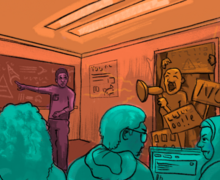SU climate strike activists discuss further action
Sarah Lee | Contributing Photographer
More than 200 people attended Syracuse’s Global Climate Strike protest.
Syracuse University and SUNY-ESF professors and students who participated in Friday’s 2019 Global Climate Strike said they were pleased with the turnout on Friday.
But they added more can be done to capture the government and public’s attention. Thousands of cities worldwide participated in the 2019 Global Climate Strike. More than 200 people attended Syracuse’s protest, which began on the SU Quad and moved to Forman Park.
Members of the central New York chapter of Sunrise Movement, a national climate activist organization, and the New York Public Interest Research Group organized the Syracuse protest. Emberlin Leja, a senior sociology major, was one of the Sunrise Movement members who helped to put the protest together.
After the strike, Leja cried in happiness at the number of young people who came to the event. She referenced students from Nottingham High School who attended the event. The school’s principal, Wil Mecum, was one of the only administrators to excuse students from classes that day.
“It was inspiring to see young people taking action even if people in power weren’t doing that,” Leja said.
Leja organized the Syracuse chapter of Sunrise Movement in 2018 with Liam McMonagle, senior broadcast and digital journalism and political science dual major, and Tamia Parsons, a sophomore in the David B. Falk College of Sport and Human Dynamics. Leja is excited to see how the movement has grown from a small group of people picketing outside the state office to marches with hundreds of people, she said.
At Friday’s strike, she spoke about the people who didn’t attend the march, saying they chose to be “climate complacent.” She told The Daily Orange that there are government officials that Sunrise CNY invited who didn’t attend or sign a pledge to deny donations from fossil fuel companies. Politicians, company executives and school administrators could have benefitted from listening to young people at the march, she said.
The Global Climate Strike will hold a second day of marches this Friday. Leja and other Sunrise CNY members have not decided whether they will organize a second march in Syracuse, she said.
Matthew Huber, an associate professor in SU’s geography department of Maxwell School of Citizenship and Public Affairs, said strikes, not marches, will accomplish the goals of the climate protests. Strikes have historically shut entire systems down in a way that compels people in power to fulfill demands, he said.
“If you’re able to shut down those institutions, such as profit-making businesses or public institutions like schools, then you’re really shutting down the very nature of society,” he said. “Once you do that, you demand force and action from the people in power.”
Huber recommends that students coordinate with their teachers to arrange a national teacher strike. As an example, he referenced the Massachusetts Teachers Association, who proposed a national teachers strike for the Green New Deal, he said. He said he believes this type of action will earn the government’s attention.
The Green New Deal is proposed federal legislation to address climate change and economic inequality.
Samantha LaSalle, a sophomore environmental science major at SUNY-ESF, said disinterest in climate change stems from a lack of education about the topic. Syracuse residents would care a lot more if they learned about how climate change will impact central New York in the future, she said.
Huber said the main solution is for politicians to inform people about the personal benefits that come with fighting the climate crisis. People will support the Green New Deal not because of environmental benefits, but because it will make housing and electricity more affordable to them, he said.
“If people start to realize that this movement will improve everybody’s lives very directly and will solve planetary crisis of climate change, then they are more willing to support and fight for it,” Huber said.
Lauren Kelly, a sophomore environmental studies major at ESF, said scientists need to communicate their data in a way that relates to the public. If scientists give statistics that people do not understand, people won’t want to get involved with the movement, she said.
“Their statistics need to connect to the people,” Kelly said. “If scientists say, ‘You have until 2050 to save your life,’ that will have more of an impact than just stating the number of species we lose every year.”
Published on September 25, 2019 at 11:19 pm
Contact Abby: akweiss@syr.edu | @abbyweiss_21





